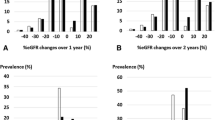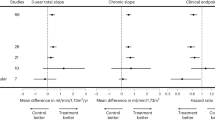Abstract
Background
The evaluation of the progression of renal insufficiency, or decline in glomerular filtration rate (GFR), has been approached more simply and precisely by converting measured serum creatinine value into the reciprocal of serum creatinine, estimated GFR, or other parameters. Doubling of serum creatinine (simple doubling) is conveniently used as a surrogate endpoint for progression of renal disease but is thought to be biased unfairly by the initial value of serum creatinine (ScrInt). We proposed the definite decline in the reciprocal of serum creatinine (2–4 doubling) as a surrogate endpoint, comparing simple doubling with this new endpoint to verify the effect of ScrInt on the endpoint.
Methods
For the purpose of comparison between endpoints, 194 patients in a historical cohort of chronic glomerulonephritis were investigated. Kaplan–Meier survival analysis was performed with the composite endpoint of need for dialysis and either simple doubling or 2–4 doubling. Then, the distribution of ScrInt was compared between total patients and patients developing each endpoint.
Results
The endpoint value of serum creatinine (ScrEnd) with 2–4 doubling was lower than that with simple doubling at ScrInt <2.00 mg/dl, and the difference of ScrEnd between simple doubling and 2–4 doubling was larger, as ScrInt became lower. In patients reaching simple doubling, ScrInt was higher than that of the total patients (1.66 vs. 1.07 mg/dl in median, respectively; p < 0.001). In patients reaching 2–4 doubling, there was no significant difference in ScrInt.
Conclusion
Patients with low serum creatinine concentration at baseline had a tendency of prolonged development into simple doubling. In contrast, with 2–4 doubling, there was no bias of ScrInt.





Similar content being viewed by others
References
Levey AS, Eckardt KU, Tsukamoto Y, Levin A, Coresh J, Rossert J, et al. Definition and classification of chronic kidney disease: a position statement from Kidney Disease: Improving Global Outcomes (KDIGO). Kidney Int. 2005;67:2089–100.
Gretz NM. How to assess the rate of progression of chronic renal failure in children? Pediatr Nephrol. 1994;8:499–504.
Stevens LA, Greene T, Levey AS. Surrogate endpoints for clinical trials of kidney disease progression. Clin J Am Soc Nephrol. 2006;1:874–84.
Rossing P. Doubling of serum creatinine: is it sensitive and relevant? Nephrol Dial Transpl. 1998;13:244–6.
Matsuo S, Imai E, Horio M, Yasuda Y, Tomita K, Nitta K, et al. Revised equation for estimated GFR from serum creatinine in Japan. Am J Kidney Dis. 2009;53:982–92.
Horio M, Orita Y. Comparison of Jaffé rate assay and enzymatic method for the measurement of creatinine clearance. Jpn J Nephrol. 1996;38:296–9.
Kaplan EL, Meier P. Nonparametric estimation from incomplete observations. J Am Stat Assoc. 1958;53:457–81.
Maschio G, Alberti D, Janin G, Locatelli F, Mann JF, Motolese M, et al. Effect of the angiotensin-converting-enzyme inhibitor benazepril on the progression of chronic renal insufficiency. The Angiotensin-Converting-Enzyme Inhibition in Progressive Renal Insufficiency Study Group. N Engl J Med. 1996;334:939–45.
The GISEN Group. Randomised placebo-controlled trial of effect of ramipril on decline in glomerular filtration rate and risk of terminal renal failure in proteinuric, non-diabetic nephropathy. Lancet. 1997;349:1857–63.
Hou FF, Zhang X, Zhang GH, Xie D, Chen PY, Zhang WR, et al. Efficacy and safety of benazepril for advanced chronic renal insufficiency. N Engl J Med. 2006;354:131–40.
Lewis EJ, Hunsicker LG, Clarke WR, Berl T, Pohl MA, Lewis JB, et al. Collaborative Study Group. Renoprotective effect of the angiotensin-receptor antagonist irbesartan in patients with nephropathy due to type 2 diabetes. N Engl J Med. 2001;345:851–60.
Brenner BM, Cooper ME, de Zeeuw D, Keane WF, Mitch WE, Parving HH, et al. The RENAAL Study Investigators. Effects of losartan on renal and cardiovascular outcomes in patients with type 2 diabetes and nephropathy. N Engl J Med. 2001;345:861–9.
Hou FF, Xie D, Zhang X, Chen PY, Zhang WR, Liang M, et al. Renoprotection of Optimal Antiproteinuric Doses (ROAD) study: a randomized controlled study of benazepril and losartan in chronic renal insufficiency. J Am Soc Nephrol. 2007;18:1889–98.
Kuriyama S, Tomonari H, Yoshida H, Hashimoto T, Kawaguchi Y, Sakai O. Reversal of anemia by erythropoietin therapy retards the progression of chronic renal failure, especially in nondiabetic patients. Nephron. 1997;77:176–85.
Jafar TH, Schmid CH, Landa M, Giatras I, Toto R, Remuzzi G, et al. Angiotensin-converting enzyme inhibitors and progression of nondiabetic renal disease. A meta-analysis of patient-level data. Ann Intern Med. 2001;135:73–87.
Casas JP, Chua W, Loukogeorgakis S, Vallance P, Smeeth L, Hingorani AD, et al. Effect of inhibitors of the renin–angiotensin system and other antihypertensive drugs on renal outcomes: systematic review and meta-analysis. Lancet. 2005;366:2026–33.
Shemesh O, Golbetz H, Kriss JP, Myers BD. Limitations of creatinine as a filtration marker in glomerulopathic patients. Kidney Int. 1985;28:830–8.
Mitch WE, Walser M, Buffington GA, Lemann J. A simple method of estimating progression of chronic renal failure. Lancet. 1976;2:1326–8.
Author information
Authors and Affiliations
Corresponding author
About this article
Cite this article
Takeuchi, N., Takenoshita, E., Kato, F. et al. Doubling of serum creatinine: is it appropriate as the endpoint for CKD? Proposal of a new surrogate endpoint based on the reciprocal of serum creatinine. Clin Exp Nephrol 15, 100–107 (2011). https://doi.org/10.1007/s10157-010-0365-1
Received:
Accepted:
Published:
Issue Date:
DOI: https://doi.org/10.1007/s10157-010-0365-1




